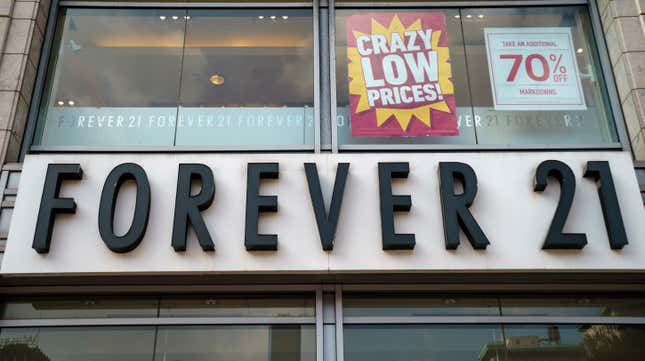
Has “fast-fashion” moved too fast? That’s the question many industry insiders are asking, after millennial and Gen Z fast-fashion favorite Forever 21 filed for bankruptcy late Sunday night, confirming concerns that had been mounting for months about the retailer’s future.
As reported by the New York Times, as a result of the Chapter 11 filing, as many as to 350 stores are due to close worldwide—approximately 178 of which will be U.S. locations—and operations will cease entirely in 40 countries, including Canada and Japan, while locations will be maintained in Mexico and Latin America. The retailer’s Riley Rose beauty boutiques are expected to close and be absorbed into existing locations; online operations are not expected to be affected.
Per a letter posted to the retailer’s website:
Today, Forever 21, Inc. voluntarily filed for bankruptcy protection under chapter 11 of the U.S. Bankruptcy Code. Essentially this allows Forever 21 to continue to operate its stores as usual, while the Company takes positive steps to reorganize the business so we can return to profitability and refocus on delivering incredible styles and fashion you love for many years to come. This does NOT mean that we are going out of business – on the contrary, filing for bankruptcy protection is a deliberate and decisive step to put us on a successful track for the future...
We are confident this is the right path for the long-term health of our business. Once we complete a reorganization, Forever 21 will be a stronger, more viable company that is better positioned to prosper for years to come. We look forward to continuing to provide you with the great service and curated assortment of merchandise that you expect from us.
According to a statement released by the company, the drastic downsizing is part of a “global restructuring” which will return the 35-year-old company, founded by South Korean immigrants Do Won and Jin Sook Chang, to profitable margins, if not its former glory.
“This was an important and necessary step to secure the future of our Company, which will enable us to reorganize our business and reposition Forever 21,” said Executive Vice President Linda Chang, daughter of the company’s founders.
But what does this mean for fans of the brand’s accessible, on-trend aesthetic, who prefer the brick and mortar experience? As of now, there is no further information on which locations will be closing.
“The decisions as to which domestic stores will be closing are ongoing, pending the outcome of continued conversations with landlords,” a company spokesperson told Glamour. “We do, however, expect a significant number of these stores will remain open and operate as usual, and we do not expect to exit any major markets in the U.S.”
Forever 21’s financial crisis follows the trajectory of several other major retailers, including one of its main competitors, Topshop, which closed all of its U.S. stores this spring. Luxury retailer Barneys New York similarly filed for bankruptcy in August, further raising the question of whether traditional brick and mortar stores can meet the needs and shopping habits of a market that has increasingly relied on the convenience of online shopping.
Insiders speculate that Forever 21’s current need to scale back is the result of over-aggressive growth; in 2014, the retailer announced plans to double the size of its retail operations to 1,200 stores; currently the company operates around 800 locations.
As reported by Fashionista:
Does Forever 21’s failure to maintain the level of demand it had in its heyday suggest that cheaply produced $5 dresses may not be a sustainable business model, or signal trouble for the fast-fashion market as a whole? That may be a bit of a stretch, as Forever 21 had some other issues, among them: opening too many stores, particularly in underperforming malls as shopping preferences shifted online; various lawsuits and call-outs over allegations ranging from copyright infringement to cultural insensitivity to labor violations to body shaming, all creating bouts of bad press; plus, Forever 21 likely lost market share to digital-first fast-fashion companies like ASOS and Fashion Nova. Meanwhile, options are increasing for more socially and environmentally conscious shoppers to shop secondhand or through rental services.
With a seeming lack of foresight into consumer tastes, does Forever 21 really have staying power? As the next generation of the company’s leadership (Do Won Chang remains the company’s chief executive), Linda Chang certainly hopes so, taking a pragmatic approach to stemming the company’s overgrowth. “What we’re hoping to do with this process is just to simplify things so we can get back to doing what we do best,” she told the Times. “I think there are definitely shifts there that are happening...It’s still a massive market but we do want to make sure we get ahead of things and that we’re not just staying still while the consumers are changing.”



